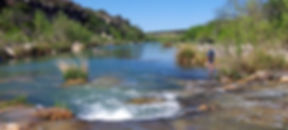How do fish react during flooding?
By Tim Grabowski (U.S. Geological Survey, Texas Cooperative Fish and Wildlife Research Unit) FLOODS OFFER CHALLENGES AND OPPORTUNITIES TO FISHES In late May 2015, a series of storms produced the wettest month ever recorded in Texas and effectively marked the end of one of the worst droughts seen in the state. Flood events are essential for maintaining the long-term health and diversity of Texas streams, rivers and bays. The dramatic increase in flows and current velocities associated with flood events help to clear out accumulated debris and sediment, re-working the substrate and morphology of the channel and restoring or rebuilding important instream habitat features, such as gravel bars and riffles. In rivers that have a tendency to support excessive growth of either native or invasive aquatic vegetation, such as the Colorado River downstream of Longhorn Dam in Austin, large flood events clear out vegetation-choked channels and restore the instream habitat diversity necessary for a riverine species. The influx of freshwater is also important for the bays and estuaries along the coast as it reduces salinities and increases productivity. At the same time, an observer standing near a river at flood stage could be forgiven for wondering what happens to all the fish living in the river. Do all of them wind up being washed into the ocean?
From the perspective of riverine fishes, flood events provide both challenges and opportunities. However before individual fish are able to reap any benefits from a flood event, they must avoid being swept away by the high current velocities generated by the flood. This is certainly a very real threat for smaller fish, but even larger individuals may expend unsustainable amounts of energy trying to maintain position against the current during a flood. Therefore some fishes find shelter within the river channel and hunker down, staying in place and riding out the flood pulse. Others may seek refuge in smaller tributaries where current velocities may not be as extreme. In contrast, some species take advantage of the availability of new habitat and leave the river channel entirely. When a river spills over its banks, it floods the forests, fields, and in some cases streets and houses, on its floodplain. This newly inundated habitat represents both a velocity refuge and a potential smorgasbord for the fish that enter it. Terrestrial insects and other invertebrates offer a readily available feast for riverine fishes. The nutrients unlocked from flooded soils and the availability of detritus and organic matter from flooded leaf litter can fuel high levels of zooplankton and aquatic macroinvertebrate productivity if flood conditions persist for long enough, continuing the all-you-can-eat nature of flood events. However, it is not necessarily good times for all the fish on the floodplain. Piscivorous fishes, such as Largemouth Bass, Flathead Catfish, and gars, may have a more difficult time locating prey as smaller prey species disperse across a wider area. There is also a risk of being cut off from the river channel when the water recedes, so fishes may be hesitant to venture too far onto the floodplain. During the recent flood events on the Colorado River, we were able to observe radio-tagged Guadalupe Bass lingering at the margins of the channel and potentially even on the floodplain itself. Whether these individuals were actively foraging or just trying to get out of the fast-moving current is unknown.
The inundated floodplain habitats also provide an important connection to the numerous oxbow lakes and other off-channel aquatic habitats that are typically isolated from the river proper. During periods of normal flows, these isolated aquatic habitats are highly productive and tend to lack larger, predatory fishes making them ideal nurseries. Numerous species of riverine fishes take advantage of these habitats and either enter floodplain habitats to spawn, such as Alligator Gar, or move into these habitats as juveniles during flood events. The young fish are trapped in the oxbows and other off-channel aquatic habitats until the next large flood event, but until then are able to grow and develop in a sheltered and productive habitat. Some species of fishes seem to be unable to successfully reproduce without having access to these habitats, while others, such as Spotted Sucker and many of the sunfishes, seem to produce stronger year-classes in years where they are able to access floodplain habitats. Alligator Gar seem to fall into the category of species that require flood events to successfully reproduce. Recognition of this dependency has led to the species being protected in some systems, such as the Trinity River, through fishery closures during periods of high water to prevent the capture of spawning adults.




